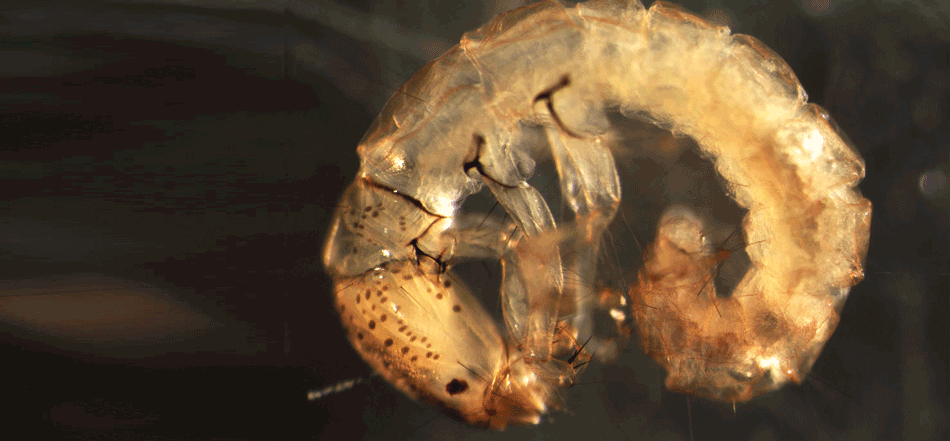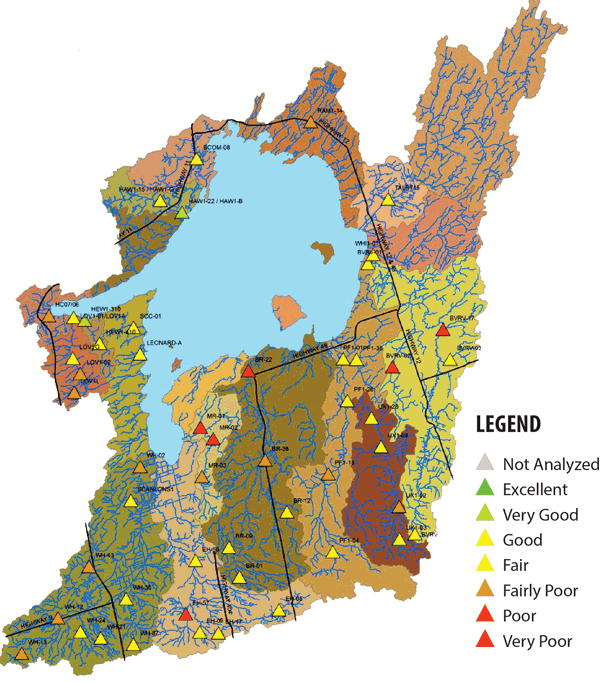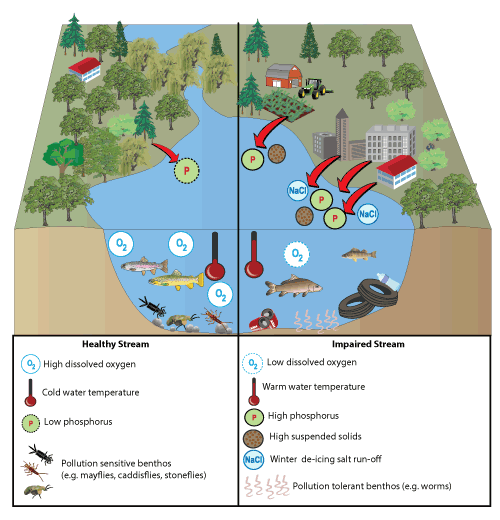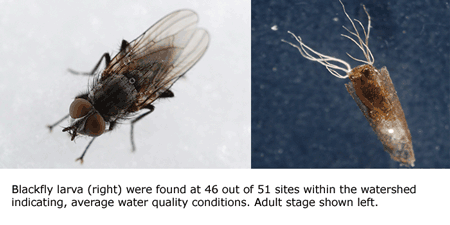
Lake Simcoe Science
Benthic Macoinvertebrates
Our Creature Feature
Bugs are vital to our own existence; they ensure we have fruits and vegetables to eat by pollinating flowers. A world without bugs would be a world without humans.
Aquatic insects found in the rivers, streams and lake also play a vital role in ensuring a healthy environment. Bugs eat material such a dead leaves or algae and they feed larger animals, thus playing an essential part of nature’s food web.
Lake Simcoe Watershed Benthic Monitoring Sites

The index used to interpret benthic macroinvertebrate data ranges from Excellent to very poor. In the lake Simcoe watershed there are no excellent scores but likewise there are no very poor. The majority of sites fall into fair
The Stories Bugs Tell
The presence of different types of bugs in the Lake Simcoe watershed can tell us a lot about its health.
Certain bugs tolerate pollution better than others. When we collect samples, we can tell by the presence and abundance of various species what the water’s health is like. Our research helps to corroborate our other scientific findings such as our water sampling done via laboratory analysis, measuring things like phosphorus and dissolved oxygen.
Lake Simcoe Region Conservation Authority employs aquatic biologists who collect, identify and translate the stories and learnings from the bugs in waters of our watershed. Knowing the tolerances of various species can tell us a lot about the environmental conditions in which they were found. Unlike a water quality sample that only represents the water quality at the time it was taken, invertebrates are exposed to that water for their entire life, so speak to the long term quality and fluctuation in the health of the river
Actually, we’re talking about a very specific group of bugs, some of which aren’t technically bugs at all. They’re benthic macro invertebrates. Benthic means they live in the bottom of lakes, rivers and ponds; macro means they are large enough to be seen by the naked eye; and invertebrate means they have no backbone.
Benthic macroinvertebrates are organisms without backbones, that are visible with the naked eye, living on the bottoms of streams, river, lakes, and ponds.
You may know benthic macro invertebrates as the flying insects they morph into, such as blackflies, dragonflies and mayflies. But we study them in their larvae form, when they are still in the water, and before they take flight. Benthic invertebrates also include worms and even some crustaceans.
Benthic macro invertebrates are a good animal group to study because they don’t move around much – at least not in the larvae stage, when we study them. They stay pretty much where they are throughout that part of their life. So we can take samples year after year and know that the changes in bug populations are a result of environmental conditions and not their movement.
We also study benthic macro invertebrates because there are so many. Taking some out of the environment for our sampling program has no negative impact on their populations. It’s also a relatively inexpensive way of gathering information about watershed health in comparison to using some other methods – for instance chemical analysis of water is more costly. Also, chemical water sampling only reveals water quality at a specific point in time and also cannot speak to other stressors that may impact the health and habitat in which the bugs live. Because bugs live in the water their whole lives, they can tell us a much more inclusive story.
Benthic Community in Healthy Stream vs. Impaired Stream

A healthy stream (left side), supporting a population of pollution intolerant benthic macroinvertibrates is typically characterized by a higher proportion of naturalized cover throughout the catchment as well as a healthy vegetated buffer along the stream banks.
Dissolved oxygen levels will be high with low phosphorus total suspended solids levels as well as cooler temperatures. The stream bed is composed of gravel and cobbles providing good habitat.
By comparison, an impaired stream (right side) will likely have a higher proportion of anthropogenic activities throughout the catchment (agriculture or urbanization). Higher pollutant inputs such as phosphorus, salt and suspended solids. As suspended solids settle in the stream bed it covers the natural gravel substrate resulting in poorer habitat for bugs. As such pollution tolerant invertebrates such as worms will typically dominate these systems.
Interpreting Their Stories
LSRCA staff have been monitoring bugs since 2002, taking samples of the mud and water at the bottoms of rivers and streams throughout the watershed. We do this once per year at 51 locations in the watershed, collecting 2 samples per site. In total, we take approximately 100 samples over the course of a year and have therefore collected hundreds of thousands of bugs.
How we translate the individual tales into a larger story about our watershed health is where it gets a bit complicated. Each bug is assigned a pollution tolerance value because we know some bugs need cleaner water than others. So we add up the bugs, take into account the tolerance values, and end up with an overall calculation or index of stream health ranging from very poor to excellent.
The overall story that bugs tell us for this watershed is pretty good. In general the headwater streams (where streams start) are doing much better than streams in urbanized or agricultural areas.
While we don’t have any “excellent” ratings, we also don’t have any “very poor” sites either. We’d like to think that our work is making a difference. Our efforts are helping to counteract the damage that is being done as a result of human activity (be it urbanization, agriculture, poor practices such as dumping toxics into storm drains, using too much winter salt, etc). That said the majority of sites (35%) fall into the fair category indicating that there is still work to be done to improve the health of the Lake Simcoe watershed. Nearly equal are the percent of sites that are ranked good (25%) and fairly poor (24%).
Three Different Bug Stories
Stressed Water Quality Conditions
A “Damselfly” in Distress

Damselfly larva (Lestidae) are tolerant of poorer water quality. Their presence is an indicator of stressed water quality conditions and are, unfortunately, very common in the Lake Simcoe watershed. They are found in the standing water of stream pools, ponds and marshes, attached to vegetation and fallen trees and branches.
Damselflies feed on aphids and mosquitos so do provide some benefit to humans, but overall, their presence indicates poor watershed health.
Average Water Quality Conditions
Blackfly

Blackflies (Simuliidae) indicators of average water quality and are also fairly common in the watershed. In the larvae stage, they are found in swift, well oxygenated waters, attached to rocks, woody debris and vegetation near riffles (fast moving, churning areas of water, such as when water travels across rocky areas in a stream).
Blackfly larvae hatch in late spring and remain as adults for 4 – 6 weeks while they feed on the blood of other animals.
Good Water Quality Conditions
Dragonfly

Dragonfly larva (Corduliidae) cannot tolerate degraded water quality and are therefore indicators of good water quality conditions. In their larvae stage, they can be found in cool marshes, pond and pools of streams. They hatch into adults at the same time as mayflies – mayflies being their primary source of food – and remain adults into July.
Dragonflies are easy to identify because of their big green eyes. They also have a distinct flying pattern like a helicopter, hovering over their prey. Dragonflies eat insects like mosquitos and midges.
The bug stories also support what our water quality sampling tells us. But what makes the bug stories so much more interesting is that the bugs are actual on the ground results of how biological systems are responding to chemical changes in the water (like phosphorus, nitrogen, chloride, etc), physical changes (like channel alteration) or landscape changes (like decreases in natural cover and vegetated buffers).
Long term benthic invertebrate monitoring sites showing trends (2002-2014)
| Subwatershed | Site | Trend | Cause | Years of Data |
|---|---|---|---|---|
| Beaver River | Mid Reach | Improving | Fewer pollution tolerant species, increase in EPT species | 10 |
| West Holland River | Headwater Tributary | Degrading | Increase in pollution tolerant worm and crustacean species | 10 |
| Whites Creek | Lower Reach | Improving | Fewer pollution tolerant species, increase in EPT species | 10 |
| Maskinonge River | Northern Tributary | Degrading | Increase in pollution tolerant worm and crustacean species | 5* |
| Pefferlaw River | Lower Reach | Improving | Fewer pollution tolerant species, increase in EPT species | 5* |
| West Holland River | Scanlon Tributary | Improving | Fewer pollution tolerant species, increase in EPT species | 4* |
| West Holland River | Northern Reach | Improving | Fewer pollution tolerant species, increase in EPT species | 7* |
*not enough data to consider significant
For the majority of the 51 sites routinely sampled throughout the Lake Simcoe watershed the data shows that the sites are stable, showing neither improvement nor degradation. In total seven sites show a trend, five of which are improving trends and only two of which are degrading trends. For both degrading trends an increase in pollution tolerant worm and crustacean species are driving the trend and indicating continued or increasing levels of pollution.
In contrast the five improving trends are being driven by increases in the abundance of intolerant species, specifically within the taxa of Ephemeroptera (mayflies), Plecoptera (stoneflies), and Trichoptera (caddisflies), or EPT, and a reduction in the number of pollution tolerant species, indicating improvements in water quality and habitat conditions. The continued collection of the benthic macroinvertebrate data will allow for the ongoing monitoring and evaluation of these trends as well as monitoring for changes in 44 sites reporting stable trends.
Don’t Shrug the Bug
Next time you are tempted to shirk a fellow bug, consider the stories they tell, the research they facilitate, and their role in a healthy watershed.
Who to Contact:
Customer Service
Phone: 905-895-1281
Toll Free: 1-800-465-0437
Email: info@LSRCA.on.ca
This newsletter was published in Lake Simcoe Living Magazine in 2015.
